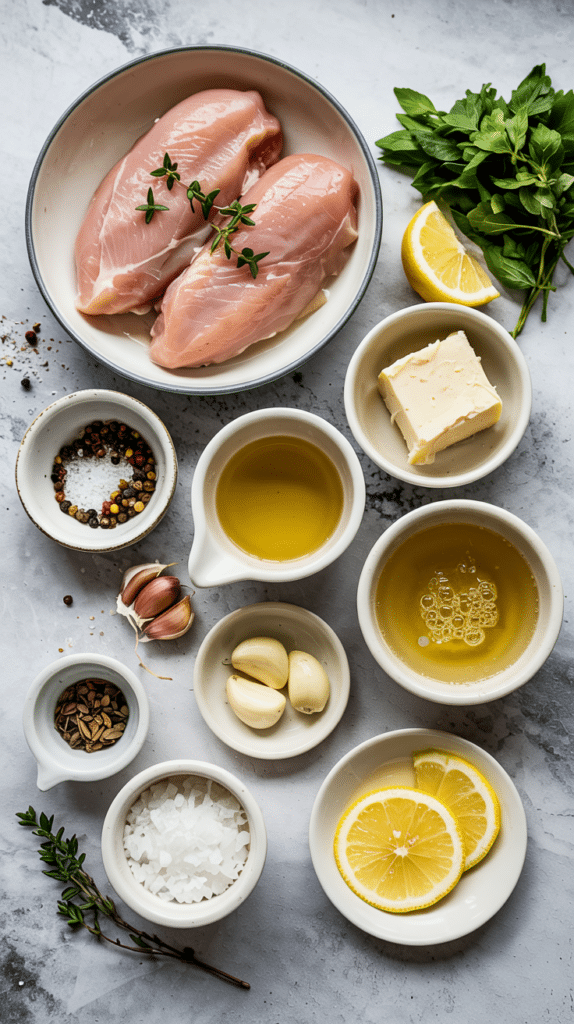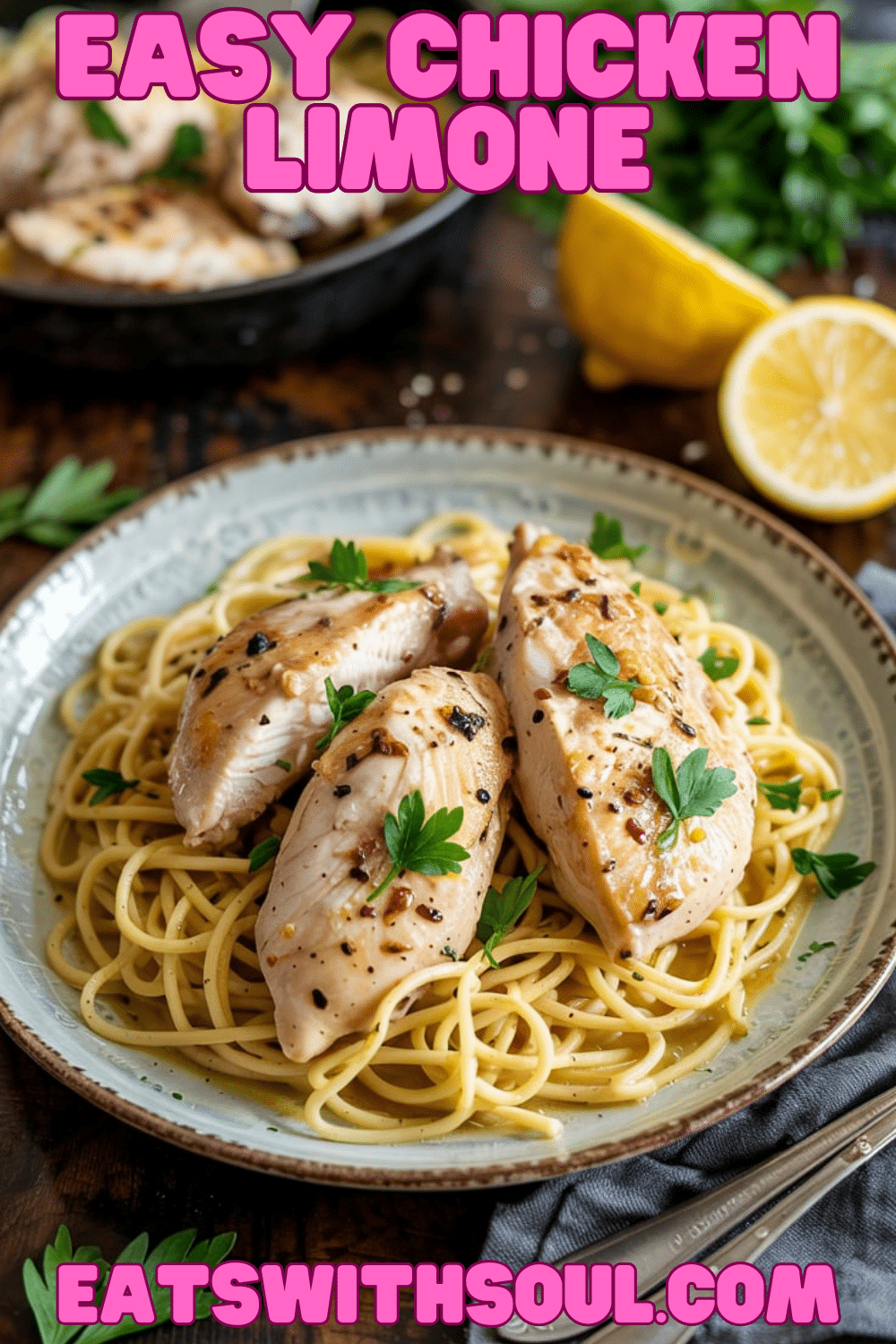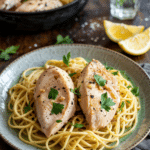Introduction & Inspiration
Sometimes the most elegant dishes are surprisingly simple, and this Easy Chicken Limone is a perfect example! Imagine tender, thin chicken breast cutlets, perfectly golden brown, bathed in a luscious pan sauce bursting with bright lemon flavor, rich butter, savory chicken broth, aromatic shallots, garlic, and fresh thyme. It’s a taste of Italian-American sunshine, ready in minutes.
My inspiration for this recipe comes from classic dishes like Chicken Piccata, but simplified for maximum ease without sacrificing flavor. I wanted a go-to recipe for a quick chicken dinner that felt sophisticated, relied on pantry staples, and delivered a truly delicious result every time. The lemon-butter pan sauce is key!
This dish is perfect for a busy weeknight when you want something flavorful and fast, but it’s also elegant enough to serve to guests. The brightness of the lemon makes it feel light yet satisfying. It is a perfect restaurant style dish, made at home.
Nostalgic Appeal / Comfort Factor
Pan-fried chicken cutlets served with a simple lemon-butter sauce have a timeless, classic appeal. It evokes feelings of cozy Italian trattorias or elegant home-cooked meals. The combination of butter, lemon, garlic, and herbs is fundamentally comforting and sophisticated all at once.
While dishes like Chicken Piccata (which often includes capers and sometimes wine) might be more widely known, this simplified “Limone” version captures that same essential bright, savory, buttery comfort. It’s satisfying without being heavy.
It’s a refined take on comfort food, offering bright, clean flavors in a simple yet elegant preparation. A perfect dish to enjoy with family and friends.
Homemade Focus (Simple Pan Sauce)
This recipe beautifully demonstrates the power of simple homemade techniques, particularly in creating a flavorful pan sauce from scratch. We’re seasoning and pan-frying fresh chicken cutlets, then using the same skillet to build a delicious sauce with shallots, garlic, broth, fresh lemon, thyme, and butter.
The process of sautéing the aromatics and deglazing the pan (implicitly, by adding broth and scraping up browned bits) captures all the flavorful fond left from cooking the chicken. Finishing the sauce with fresh lemon juice, zest, and thyme ensures a vibrant, homemade taste far superior to any bottled sauce. Using gelatin or glucomannan (an unusual but effective thickener) is another homemade touch to achieve the desired consistency.
It’s about using fresh ingredients and classic pan sauce techniques, simplified, to create a restaurant-quality meal easily at home. The homemade taste is incredible.
Flavor Goal
The primary flavor goal is a bright, savory, and buttery chicken dish dominated by fresh lemon. The chicken itself should be tender, juicy, and lightly golden, seasoned simply to complement the sauce.
The pan sauce is where the magic happens: it should be bright and tangy from the lemon juice and zest, rich from the butter, savory from the chicken broth and aromatics (shallot, garlic), and herbaceous from the fresh thyme. It should be slightly thickened, just enough to coat the chicken beautifully.
The overall experience should be light yet flavorful, with the tangy lemon balancing the rich butter, creating a sophisticated and refreshing main course. A perfect balance between flavour and texture.
Ingredient Insights
- Boneless, Skinless Chicken Breast Fillets: Using fillets (often meaning breasts already sliced thinner, or slicing whole breasts yourself) ensures quick and even cooking. Pounding them thin also works well.
- Salt Flakes and Black Pepper: Essential seasoning for the chicken. Using salt flakes offers nice texture.
- Olive Oil & Salted Butter: Used in combination for cooking. Olive oil provides a higher smoke point for the initial sear, while butter (added later) provides rich flavor for the sauce. Using salted butter adds flavor depth.
- Golden Shallot (Finely Chopped): Provides a milder, more delicate onion flavor than a regular yellow or white onion, perfect for a quick pan sauce.
- Garlic (Finely Chopped): Essential aromatic flavor base.
- Chicken Stock or Broth: Creates the liquid base for the pan sauce and helps deglaze the pan. Use a good quality low-sodium broth if possible.
- Gelatin or Glucomannan Powder: An unusual but effective thickener for the sauce. Gelatin needs to be bloomed briefly (though not specified, usually sprinkled on cold liquid) or simply whisked well into the broth. Glucomannan is a fiber that thickens liquids. A traditional cornstarch slurry (1 tsp cornstarch + 1 tbsp cold water) could likely be substituted if preferred.
- Fresh Thyme Leaves: Adds a lovely earthy, slightly floral herbal note that pairs beautifully with lemon and chicken.
- Lemon Zest & Fresh Lemon Juice: The stars of the sauce! Zest provides aromatic oils, juice provides bright acidity. Freshly squeezed juice is crucial.
- Lemon Slices & Fresh Parsley: For garnish, adding visual appeal and extra freshness.
Essential Equipment
- Large Skillet: Essential for searing chicken and making the pan sauce. A pan that holds heat well (like stainless steel or cast iron) is great for developing fond, but non-stick works too.
- Knife & Cutting Board: For slicing chicken (if needed), chopping shallot, garlic, parsley, slicing lemon.
- Tongs or Spatula: For handling the chicken.
- Whisk (Optional): Useful for incorporating the gelatin/thickener smoothly into the broth.
- Measuring Cups & Spoons:
Ingredients
(Based on 1x column)
Chicken:
- ▢ 2 chicken breast fillets (about 250g / 1/2 pound each), sliced into thinner cutlets if thick
- ▢ Salt flakes and black pepper, to taste
- ▢ 1 tablespoon olive oil
- ▢ 1 tablespoon salted butter (plus potentially more for finishing sauce if desired)
Lemon Sauce:
- ▢ 1 golden shallot, finely chopped
- ▢ 2 cloves garlic, finely chopped
- ▢ 3/4 cup chicken stock or broth
- ▢ 3 teaspoons gelatin (or 1/2 teaspoon glucomannan powder) (See Note)
- ▢ 1 teaspoon fresh thyme leaves
- ▢ 1 teaspoon finely grated lemon zest
- ▢ 3 tablespoons fresh lemon juice
Garnish:
- ▢ Lemon slices
- ▢ Freshly chopped parsley
(Note on thickener: 3 tsp gelatin seems like a lot for only 3/4 cup liquid unless aiming for significant body. Traditionally, a cornstarch slurry or reduction achieves thickening. Follow as written, or substitute with 1 tsp cornstarch mixed with 1 tbsp cold water if preferred.)

Step-by-Step Instructions
1. Prepare and Season Chicken:
- If your chicken breast fillets are thick, slice them horizontally into thinner cutlets (aiming for about 1/2 inch thickness). Pat the chicken dry with paper towels.
- Season both sides of the chicken cutlets generously with salt flakes and black pepper.
2. Cook the Chicken:
- Heat the olive oil in a large skillet over medium-high heat.
- Carefully place the seasoned chicken cutlets in the hot skillet. Work in batches if necessary to avoid overcrowding.
- Cook for about 3-5 minutes per side (depending on thickness) until lightly golden brown, cooked through (internal temperature 165°F/74°C), and juices run clear.
- Remove the cooked chicken from the pan and set aside on a plate. Keep warm (e.g., tent loosely with foil).
3. Sauté Aromatics:
- Reduce the heat slightly to medium. Add the 1 tablespoon of salted butter to the same skillet.
- Once melted, add the finely chopped shallot and cook, stirring frequently, until softened and translucent, about 2-3 minutes.
- Add the finely chopped garlic and sauté for another 30-60 seconds until fragrant. Be careful not to burn the garlic.
4. Build and Thicken Sauce:
- Pour the chicken broth or stock into the skillet. Whisk in the gelatin (or glucomannan powder, or alternative thickener like cornstarch slurry). Add the fresh thyme leaves.
- Bring the mixture to a simmer, scraping up any browned bits (fond) from the bottom of the pan with your whisk or spoon – this adds lots of flavor!
- Continue to simmer, stirring occasionally, until the sauce has reduced slightly and thickened to your desired consistency, about 3-4 minutes. (Gelatin’s thickening effect becomes more apparent as it cools slightly).
5. Finish Sauce and Return Chicken:
- Stir the finely grated lemon zest and fresh lemon juice into the sauce. Stir until combined. Taste and adjust salt and pepper if needed.
- Return the cooked chicken cutlets (and any accumulated juices from the plate) back into the pan with the sauce.
- Turn the chicken gently in the sauce to coat. Cook for another minute or two, just until the chicken is heated through.
6. Serve:
- Serve the Chicken Limone immediately, spooning plenty of the lemon-butter sauce over the top.
- Garnish with fresh lemon slices and freshly chopped parsley.

Troubleshooting
- Chicken Dry/Tough: Overcooked. Chicken cutlets cook very quickly. Use a thermometer (165°F/74°C). Ensure even thickness by slicing or pounding.
- Sauce Too Thin: Didn’t simmer long enough, or thickener wasn’t effective/enough. Simmer longer to reduce, or ensure gelatin/glucomannan/cornstarch was properly incorporated and given time to work. Gelatin thickens more upon slight cooling.
- Sauce Too Thick: Simmered too long, or too much thickener used. Whisk in a splash more chicken broth or water to thin it out.
- Sauce Broken (Oily): Butter added when sauce was too hot, or sauce boiled too vigorously after adding butter (though butter is added early here). Whisking vigorously off heat can sometimes re-emulsify it.
- Garlic/Shallots Burnt: Heat was too high during sautéing. Cook aromatics over medium or medium-low heat after searing chicken.
Tips and Variations
- Pound Chicken: Pounding breasts to an even 1/4 to 1/2 inch thickness ensures super fast, even cooking and tenderness.
- Fresh Lemon is Key: Use freshly squeezed lemon juice and freshly grated zest for the best, brightest flavor.
- Thickener: If unsure about gelatin/glucomannan, a simple slurry of 1 teaspoon cornstarch mixed with 1 tablespoon cold water, whisked into the simmering broth, is a reliable substitute thickener.
- Add Capers: For a classic Chicken Piccata flavor, add 1-2 tablespoons of drained capers along with the lemon juice.
- White Wine: Deglaze the pan with 1/4 cup of dry white wine after cooking the shallots/garlic, let it bubble and reduce by half, then add the broth for more depth.
- Different Herbs: Fresh rosemary or sage could be used instead of or with thyme.
Serving and Pairing Suggestions
- Over Pasta: Classic pairing! Serve over angel hair, linguine, or fettuccine.
- With Rice or Orzo: Rice pilaf or simple orzo complements the sauce well.
- With Mashed Potatoes: Creamy mashed potatoes are great for soaking up the sauce.
- With Roasted Vegetables: Serve alongside roasted asparagus, broccoli, or green beans.
- With Crusty Bread: Essential for mopping up every last drop of the lemon-butter sauce!
- Wine Pairing: Crisp white wines like Pinot Grigio, Sauvignon Blanc, or an unoaked Chardonnay work beautifully.
Nutritional Information
(Note: Estimated, per serving, assuming 4 servings from 2 large breasts/4 cutlets. Variable based on chicken size, butter/oil amount.)
- Calories: 350-450
- Fat: 20-30g
- Saturated Fat: 8-12g
- Cholesterol: 130-180mg
- Sodium: 400-600mg+ (depending on broth and added salt)
- Total Carbohydrates: 3-6g
- Dietary Fiber: <1g
- Sugars: 1-3g
- Protein: 35-45g
Easy & Elegant Chicken Limone (Piccata Style)
Make this quick and elegant Chicken Limone! Features tender pan-fried chicken cutlets in a bright lemon-butter pan sauce with fresh thyme.
Ingredients
(Based on 1x column)
Chicken:
- ▢ 2 chicken breast fillets (about 250g / 1/2 pound each), sliced into thinner cutlets if thick
- ▢ Salt flakes and black pepper, to taste
- ▢ 1 tablespoon olive oil
- ▢ 1 tablespoon salted butter (plus potentially more for finishing sauce if desired)
Lemon Sauce:
- ▢ 1 golden shallot, finely chopped
- ▢ 2 cloves garlic, finely chopped
- ▢ 3/4 cup chicken stock or broth
- ▢ 3 teaspoons gelatin (or 1/2 teaspoon glucomannan powder) (See Note)
- ▢ 1 teaspoon fresh thyme leaves
- ▢ 1 teaspoon finely grated lemon zest
- ▢ 3 tablespoons fresh lemon juice
Garnish:
- ▢ Lemon slices
- ▢ Freshly chopped parsley
(Note on thickener: 3 tsp gelatin seems like a lot for only 3/4 cup liquid unless aiming for significant body. Traditionally, a cornstarch slurry or reduction achieves thickening. Follow as written, or substitute with 1 tsp cornstarch mixed with 1 tbsp cold water if preferred.)
Instructions
1. Prepare and Season Chicken:
- If your chicken breast fillets are thick, slice them horizontally into thinner cutlets (aiming for about 1/2 inch thickness). Pat the chicken dry with paper towels.
- Season both sides of the chicken cutlets generously with salt flakes and black pepper.
2. Cook the Chicken:
- Heat the olive oil in a large skillet over medium-high heat.
- Carefully place the seasoned chicken cutlets in the hot skillet. Work in batches if necessary to avoid overcrowding.
- Cook for about 3-5 minutes per side (depending on thickness) until lightly golden brown, cooked through (internal temperature 165°F/74°C), and juices run clear.
- Remove the cooked chicken from the pan and set aside on a plate. Keep warm (e.g., tent loosely with foil).
3. Sauté Aromatics:
- Reduce the heat slightly to medium. Add the 1 tablespoon of salted butter to the same skillet.
- Once melted, add the finely chopped shallot and cook, stirring frequently, until softened and translucent, about 2-3 minutes.
- Add the finely chopped garlic and sauté for another 30-60 seconds until fragrant. Be careful not to burn the garlic.
4. Build and Thicken Sauce:
- Pour the chicken broth or stock into the skillet. Whisk in the gelatin (or glucomannan powder, or alternative thickener like cornstarch slurry). Add the fresh thyme leaves.
- Bring the mixture to a simmer, scraping up any browned bits (fond) from the bottom of the pan with your whisk or spoon – this adds lots of flavor!
- Continue to simmer, stirring occasionally, until the sauce has reduced slightly and thickened to your desired consistency, about 3-4 minutes. (Gelatin’s thickening effect becomes more apparent as it cools slightly).
5. Finish Sauce and Return Chicken:
- Stir the finely grated lemon zest and fresh lemon juice into the sauce. Stir until combined. Taste and adjust salt and pepper if needed.
- Return the cooked chicken cutlets (and any accumulated juices from the plate) back into the pan with the sauce.
- Turn the chicken gently in the sauce to coat. Cook for another minute or two, just until the chicken is heated through.
6. Serve:
- Serve the Chicken Limone immediately, spooning plenty of the lemon-butter sauce over the top.
- Garnish with fresh lemon slices and freshly chopped parsley.
Recipe Summary and Q&A
Summary: This Easy Chicken Limone features thin chicken breast cutlets seasoned and pan-fried until golden. A simple pan sauce is made in the same skillet by sautéing shallots and garlic, adding chicken broth thickened slightly with gelatin (or alternative), fresh thyme, lemon zest, and lemon juice, then returning the chicken to heat through. It’s served garnished with parsley and lemon slices.
Q&A:
- Q: Why slice the chicken breasts horizontally?
- A: This creates thinner cutlets that cook much more quickly and evenly than thick breasts, preventing the outside from drying out before the center is cooked. It also results in more tender chicken.
- Q: What is gelatin/glucomannan powder doing in the sauce? Can I skip it?
- A: They are used here as thickening agents to give the pan sauce a slightly richer body without using flour or cream. Gelatin adds body, while glucomannan is a fiber that thickens liquids. You can skip it and simply reduce the sauce a bit longer by simmering, or use a more traditional cornstarch slurry (1 tsp cornstarch + 1 tbsp cold water whisked into simmering broth) if preferred.
- Q: Can I add capers to make it Chicken Piccata?
- A: Absolutely! Add 1-2 tablespoons of drained capers to the sauce along with the lemon juice for that classic piccata flavor.
- Q: What’s the difference between chicken stock and broth?
- A: Stock is typically made from simmering bones and has more body, while broth is usually made from simmering meat and vegetables and is often lighter. They can generally be used interchangeably in this recipe, but using a good quality, flavorful one is recommended.

